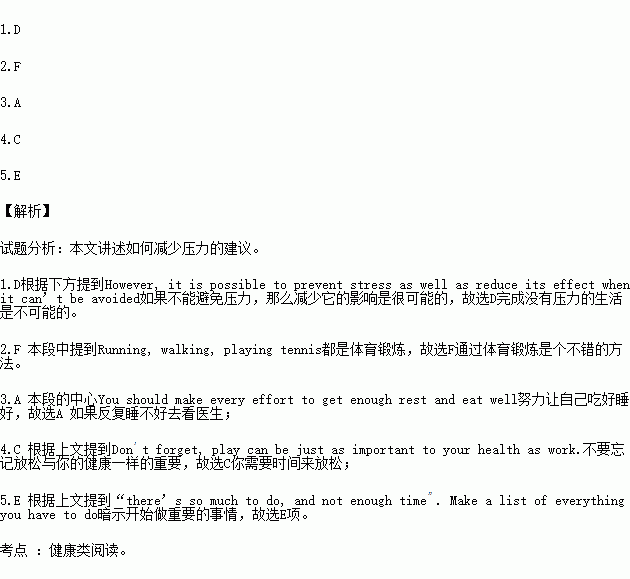题目内容
根据短文内容,从短文后的选项中选出能填入空白处的最佳选项。选项中有 两项为多余选项。
1. However, it is possible to prevent stress as well as reduce its effect when it can’t be avoided. The following are ways to deal with stress.
2. Running, walking, playing tennis, and working in your garden are just some of the activities you might try.
You should make every effort to get enough rest and eat well. If you easily get angry and can’t sleep well enough, or if you’re not eating properly, it will be more likely that you will fall into stressful situations. 3.
Schedule time for both work and entertainment. Don’t forget, play can be just as important to your health as work. 4. Go window-shopping or work on a hobby. Allow yourself at least half an hour each day to do something you enjoy.
Stress can result from disorganization and a feeling that “there’s so much to do, and not enough time”. Make a list of everything you have to do. 5. Remember: do one thing at a time, and check off each task it is completed.
A. If stress repeatedly keeps you from sleeping, you should see a doctor.
B. You’d better get into good living habits.
C. You need a break from your daily routine to just relax and have fun.
D. It is impossible to live completely free of stress.
E. Set out to do the most important task first.
F. Trying releasing the pressure through exercise is probably a good choice.
G. Stress can influence peopled thoughts and feelings.
 阅读快车系列答案
阅读快车系列答案The Metropolitan Museum of Art (Met) is one of the world’s largest and finest art museums. Following the suggested route will help you explore the museum.
The Temple of Dendur
This 2000-year-old building stood near the Nile River, surrounded by a wall that no longer exists. But you can still peek through the gateway. Whose “house” is this? It's not for people. It’s for gods. Can you identify them? They face out. A king faces in, bringing offerings.
MetSpeaks
Bringing together some of the most respected thinkers on a given subject, MetSpeaks features lectures, discussions, talks, films, and forums in which compelling voices explore timely issues that connect to the Met’s exhibitions and permanent collection. Program times, audiences, and topics vary.
Time to Sketch
Settle down for a few minutes, pick something in this gallery, and have fun drawing it. Enjoy the chance to look carefully as you create your own sketch. You'll be surprised at how much more you notice, thanks to exploring art by sketching.
MetAccess
Make the Met yours! Choose from a variety of services and exciting programs that are tailored to meet the needs of visitors with disabilities. Program times, audiences, and topics vary.
Ask for the Access Information brochure and Access Calendar at Information Desks, download the Access Calendar (PDF), or call 212-650-2010 or email access@metmuseum.org.
Admission
Fee includes admission to the Main Building and same-week admission to the Cloisters museum and gardens.
Recommended | Fee |
Adults | $25 |
Seniors (65 and older) | $17 |
Students | $12 |
Members (Join Now) | Free |
Children under 12 (accompanied by an adult) | Free |
1.How much is recommended to pay for 3 adult and 2 student visitors?
A. 99 B. 111 C. 87 D. 103
2.What can you know about the Temple of Dendur?
A. A high wall is surrounding the 2000-year-old building now.
B. A king faces out, bringing offerings in the temple.
C. The building is designed for Emperor to live in.
D. The Nile River witnessed the history of the building.
3.Which of the following is TRUE about the Met?
A. Issues connected with economic crisis will be discussed in MetSpeaks.
B. Visitors can choose something in the gallery and have fun drawing it on the wall.
C. Disabled people will find various services and programs offered especially for them.
D. You can email access@metmuseum.org for more Admission information.

